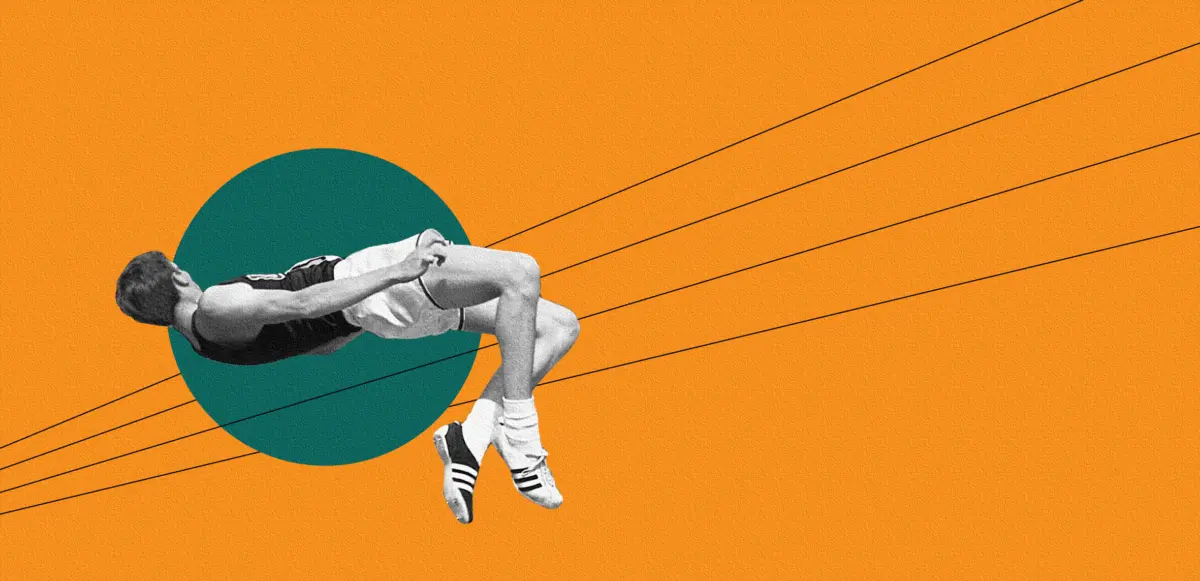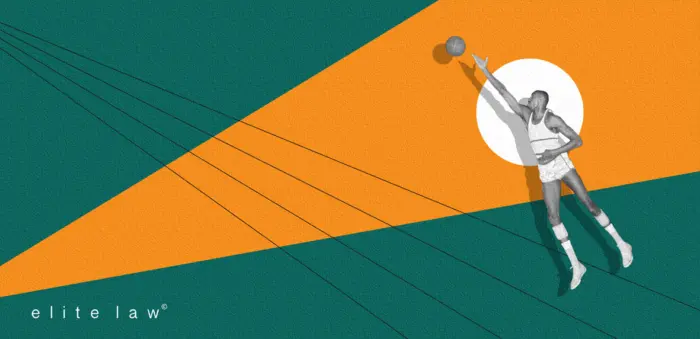‘Changing the rules of the game‘ is a phrase we have all said and heard many times. But there have been a few cases in the past where athletes have literally changed or interpreted in their own way some of the rules of the sport in which they excelled.
In this post we deal with:
- Dick Fosbury’s ‘Flop’;
- paradigm shift;
- the V-shaped skis of Jan Mauritz Boklöv;
- when change is not rewarded: Rick Barry’s free throws;
- when change is crushed: Robert John Ray’s t-shirts.
Dick Fosbury’s “Flop”
What can you do if you’re a young athlete in Portland in the 1960s, you’re crazy about high jumping, but you just can’t seem to achieve good results? You can give up and look for another sport to occupy your time. Or, if your name is Dick Fosbury, you can try, try again, study, analyse every aspect of the technique and then twist it.
At that time, the high jump was done in the ‘ventral’ or western roll style. In practice, one takes a straight oblique run-up, jumps with the belly facing the obstacle and one arm thrown upwards, trying to overcome the bar by means of a rotation of the torso on the longitudinal axis. Fosbury is quite tall (193 cm), but despite his efforts he does not even manage to qualify for the finals of his local team.
So he starts to develop what is an ‘alternative’ jumping style, which will later be called the ‘Fosbury flop’. Fosbury’s new technique, on paper, is all wrong. The athlete arrives at the jump point with the opposite foot to the one usually used, then turns in the air and jumps over the bar backwards. A nonsense, something never seen before, which provokes hilarity and jeers at first. Apparently a local newspaper even described Fosbury as ‘the world’s laziest high jumper’.
Paradigm shift
Then, however, the results start to come in. The bar is set at higher levels, and it is often jumped with some ease; while his opponents, who are much higher ranked than him, trudge through failed western rolls. His sporting career takes off, leading him to the only stage that counts. It is 1986 and Mexico is hosting the Olympic Games, those that will go down in history for the fists raised on the podium by US sprinters Tommie Smith and John Carlos. In addition to the political and social impact of their symbolic gesture, there is also room for a personal redemption story, that of Dick Fosbury.
Fosbury is not among the favourites, and he starts jumping as usual with his ‘abnormal’ technique. The high jumping world still looks at him with distrust, the risk of making a global bad impression is real. Instead, Fosbury writes history. Jump after jump he destroys his opponents and the bar rises to 2.24. If surpassed, it will be an Olympic record. Fosbury starts, jumps, turns his back and flies above the bar. It is a new Olympic record, a legendary moment. Not just a gold medal around his neck, but a radical paradigm shift for the high jump sport as a whole. From then on, no one will laugh at this strange jump anymore; on the contrary, more and more athletes will adopt and master this technique, until the actual Olympic champions Gianmarco Tamberi and Mutaz Essa Barshim, who were able to jump, with the Fosbury flop, 2 meters and 37 cm at the 2020 Tokyo Olympics (2021).
The V-shaped skis of Jan Mauritz Boklöv
Another athlete who changed the rules of his sport, perhaps by accident, was the ski jumper Jan Mauritz Boklöv. Until the late 1980s, the technique of jumping from the ski jump was quite simple. The take-off was performed by keeping the skis parallel, until they touched the ground. But in 1985, during a competition, probably to avoid falling, Boklöv formed a V with his skis while in the air. Instead of falling, the athlete reached the finish line with a great result. From that moment on, he began experimenting with this type of jump, which offered more power and control. Again, the new technique had the effect of an earthquake for the entire ski jumping movement. By the early 1990s, all jumpers would in fact have adopted the V-style.
When change is not rewarded: Rick Barry’s free throws
Fosbury and Boklöv are two emblematic cases, because their new techniques not only led them to important personal achievements, but also contributed to a definitive change in the sports in which they competed. Some other times, however, the change adopted individually by an athlete fails to make an impact on a global level. An example is the free throw in basketball. If we think about some of the star players, from Michael Jordan to Kobe Bryant, from Magic Johnson to Stephen Curry, the free throw is always the same: a fluid movement of legs and arms, a flick of the wrist forward, the fingertips letting go of the ball, the classic parabola and a perfect shot. But it is not written in any rulebook that this is the only way to shoot a free throw.
It was the legendary Rick Barry who tried to change history. A controversial player, considered among the most arrogant in American basketball history. A complex player, but a born winner, so much so that he is, to this day, the 8th best free throw shooter in NBA history, with the stellar 89.31% percentage. His innovation was to approach free throws differently than usual. Instead of shooting from the top, as everyone else did, Barry does it from underneath, i.e. by grabbing the ball with two hands and shooting it from the bottom. This way he does not have to concentrate on the ‘wrist’ movement, which he considered to be his weak point. A bit like Fosbury, the technique seems rather crude, for some a real insult to aesthetics. The result, however, is surprising. Barry is the only player in basketball history to have been a top scorer in the NCAA, the NBA and even the ABA, the American Basketball Association, a league that competed with the NBA until its merger in 1976. In spite of this achievement, his technique did not strike a chord with his peers. Even players with much lower percentages never adopted this technique to shoot free throws. One among all, Shaquille O’Neal, for whom free throws have always been a weak point (only 52.7% in his career for him). It is very likely that if O’Neal had decided to shoot from the floor, his percentages would have definitely improved, but this decidedly uncool technique has always been snubbed. In his biography Shaq Uncut: My Story, he recounts how his coach tried several times to get him to shoot from the floor, but to no avail, not least because of the determined opposition of the player’s father.
When change is crushed: the t-shirts of Robert John Ray
Then there are cases in which the adoption of a particular technique by a sportsman is not only not supported by the movement as a whole (as was the case with Barry’s shot), but even opposed by the sport regulation.
This is the case of Robert John Ray, a professional hockey player (in the Buffalo Sabres and Ottawa Senators) who was considered one of the toughest players on the circuit in the 1990s. The NHL is no joke and during the most heated games, physical contact often results in brawls. And it was precisely in these chaotic moments that Ray ‘unleashed’ his peculiarity. In fact, his clothing included a very loose jersey, so that it could be quickly pulled off to free his arms and, at the same time, to make it more difficult for his opponents to catch him. This behaviour led to the adoption of what is often called the ‘Rob Ray Rule’, a paragraph under ‘Rule 56. Fisticuffs” in the NHL rulebook:
A player who deliberately removes his sweater prior to participating in an altercation or who is clearly wearing a sweater that has been modified and does not conform to Rule 24A – Players’ Jerseys shall be assessed a minor penalty for Unsportsmanlike Conduct and a game misconduct. This is in addition to other penalties to be assessed to the participants of an altercation.
A player who engages in fisticuffs and whose sweater is removed (completely off his torso), other than through the actions of his opponent in the altercation or through the actions of the Linesman, shall be assessed a game misconduct penalty.
A player who engages in fisticuffs and whose sweater is not properly “tied-down” (sweater properly fastened to pants), and who loses his sweater (completely off his torso) in that altercation, shall receive a game misconduct.
An emblematic case in which a federation takes corrective action to specify its regulations as a result of a conduct carried in the field.
We have come to the end of this post, in which we have analysed a number of emblematic cases in which the change of a technique, even within the limits of the behaviour permitted by the rules, has sometimes led to the adoption of the new style by the entire movement, wile other times it led to a harsh opposition.
Regardless of the final outcome, these are all stories in which innovation, creativity, tenacity and talent have written pages of sporting history. All characteristics in which we at Elite Law also want to be inspired to make our daily contribution on behalf of our customers.


